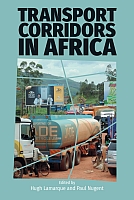Transport Corridors in Africa
| dc.contributor.editor | Lamarque, Hugh | |
| dc.contributor.editor | Nugent, Paul | |
| dc.date.accessioned | 2023-12-06T18:03:42Z | |
| dc.date.available | 2023-12-06T18:03:42Z | |
| dc.date.issued | 2022 | |
| dc.identifier | ONIX_20231206_9781800104761_21 | |
| dc.identifier | OCN: 1336406301 | |
| dc.identifier.uri | https://library.oapen.org/handle/20.500.12657/85997 | |
| dc.description.abstract | In-depth examination of the inherent tensions and dynamics of transport corridors in Africa: between short-term optics and long-term durability; between regional integration and national interest; between the facilitation of trade and the generation of corridor revenue. The image of the corridor, a central pathway of road and rail carving its way through Africa's interior, has guided the coordination of transport and trade developments on the continent in recent decades. Existing analysis of the "Corridor" - a label with a great capacity to change shape, guiding funding and infrastructural priorities at different times and in different settings - tends to be presentist, technical, and conveyed in the language of transport economics. The chapters collected here showcase a more varied approach, offering perspectives from academics and policy-makers coming from a range of disciplinary backgrounds. They capture the varied forms of the corridor concept (developmental, transport, and trade corridors), the multiplicity of actors (including China and the European Union), as well as the different permutations of the infrastructure itself, in corridors linking coastal states and in others that link coastal states with the hinterland. The breadth of cases allows for a comparative perspective of East, West, and Southern Africa, as well as the basis of comparisons outside of the continent in Europe, South Asia, and elsewhere. The motivations behind corridor initiatives in Africa range enormously, from resource extraction to urban development and poverty reduction. A lot depends on scale, and this collection places the grand designs thrashed out at continental and regional economic forums alongside the individual concerns of drivers and cross-border traders hauling goods across the continent's checkpoints. What emerges are a number of central tensions in the study of transport corridors: between short-term optics and long-term durability; between road and rail as modes of transportation; between regional integration and national interest; between the facilitation of trade and the generation of corridor revenue; between different port configurations; and between local dynamics and the dynamics of long-distance transportation. This book is available as an Open Access ebook under the Creative Commons license CC-BY-NC. | |
| dc.language | English | |
| dc.subject.other | Transport Corridors | |
| dc.subject.other | Africa | |
| dc.subject.other | Regional Integration | |
| dc.subject.other | Trade | |
| dc.subject.other | Corridor Revenue | |
| dc.subject.other | East Africa | |
| dc.subject.other | West Africa | |
| dc.subject.other | Southern Africa | |
| dc.subject.other | Coastal States | |
| dc.subject.other | Port Configurations | |
| dc.subject.other | Economic Development | |
| dc.subject.other | Infrastructure | |
| dc.subject.other | Comparative Perspective | |
| dc.subject.other | African Checkpoints | |
| dc.subject.other | Open Access | |
| dc.title | Transport Corridors in Africa | |
| dc.type | book | |
| oapen.relation.isPublishedBy | 2f51bde7-eaae-4e18-9c1c-ad757a12abea | |
| oapen.relation.isbn | 9781800104761 | |
| oapen.imprint | James Currey | |
| oapen.pages | 342 | |
| oapen.place.publication | Woodbridge |

